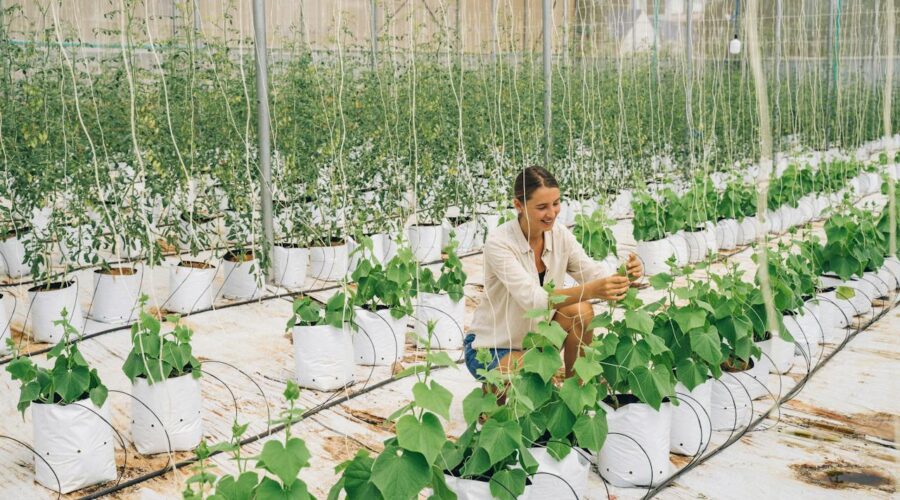In the ever-evolving world of gardening, the concept of no-till vegetable gardening is like a breath of fresh air for both seasoned horticulturists and budding green thumbs. This innovative approach not only simplifies the gardening process but also nurtures the soil and enhances the overall health of your vegetable patch. Join us on a journey into the world of no-till gardening methods, where less is more, and the results are bountiful.
Embracing the No-Till Philosophy
At the heart of no-till vegetable gardening lies the philosophy of minimal disturbance. Unlike traditional gardening methods that involve turning over the soil, no-till practices advocate leaving the soil undisturbed. This simple shift in approach offers a myriad of benefits, starting with the preservation of the delicate soil structure.
Preserving Soil Structure
No-till gardening is a silent advocate for soil health. When we refrain from disrupting the soil, we allow its natural structure to remain intact. This structure, made up of aggregates, channels, and a bustling community of microorganisms, provides an ideal environment for plant roots to explore and thrive. As a result, your vegetables enjoy improved access to nutrients and water, fostering robust growth and resilience. One of the delightful perks of no-till vegetable gardening is the built-in weed suppression. By leaving the soil surface covered with organic matter or cover crops, you create a natural barrier that inhibits weed growth. This not only reduces the need for back-breaking weeding sessions but also ensures that your vegetables have less competition for resources.
Keeping Plants Hydrated Naturally
 In the world of no-till, moisture becomes a precious resource. The organic mulch cover on the soil acts, reducing evaporation and keeping the soil consistently moist. This water-wise approach not only benefits your vegetables but also contributes to a more efficient use of water in your garden.
In the world of no-till, moisture becomes a precious resource. The organic mulch cover on the soil acts, reducing evaporation and keeping the soil consistently moist. This water-wise approach not only benefits your vegetables but also contributes to a more efficient use of water in your garden.
Encouraging Beneficial Microorganisms
Beneath the surface of a no-till vegetable garden, a bustling community of beneficial microorganisms comes to life. Earthworms, bacteria, and fungi work in harmony to break down organic matter, enriching the soil with nutrients. This natural orchestra of underground allies contributes to a thriving ecosystem that supports plant health and vitality.
Getting Started With No-Till Vegetable Gardening
- Prepare Your Garden Bed: Clear the area of any existing vegetation, then add a layer of compost or well-rotted manure to kickstart the soil with nutrients.
- Choose Your Cover Crops: Consider planting cover crops like clover or rye in the off-season. These plants not only protect the soil but also contribute organic matter when they’re eventually incorporated
- Mulch, Mulch, Mulch: Once your vegetables are planted, cover the soil with a thick layer of organic mulch. This could be straw, leaves, or even grass clippings. Mulching helps retain moisture, suppress weeds, and gradually enrich the soil as it breaks down.
- Avoid Compaction: Steer clear of walking on the garden beds, especially when the soil is wet. This helps prevent compaction and maintains the well-aerated environment that your vegetables love.
- Rotate Your Crops: To further enhance soil health and reduce the risk of pests and diseases, practice crop rotation. Moving your vegetables to different locations each season helps break pest and disease cycles.
In Conclusion
 No-till vegetable gardening is more than a gardening technique; it’s a philosophy that invites you to work with nature rather than against it. As you embark on your no-till journey, you’ll not only witness the flourishing of your favorite vegetables but also contribute to the well-being of the soil and the sustainability of your garden. So, grab your gardening gloves and join the no-till movement where simplicity reigns and the harvests abound.
No-till vegetable gardening is more than a gardening technique; it’s a philosophy that invites you to work with nature rather than against it. As you embark on your no-till journey, you’ll not only witness the flourishing of your favorite vegetables but also contribute to the well-being of the soil and the sustainability of your garden. So, grab your gardening gloves and join the no-till movement where simplicity reigns and the harvests abound.







 One thing you should check out before playing in an online casino is the available bonuses and promotions. Most online casinos offer various bonuses, so read through them carefully and understand the wagering requirements and other terms. Bonuses can be a great way to boost your bankroll, so it’s important to understand how they work and what kind of bonus you’re eligible for. Every casino offers different types of bonuses. It is known that
One thing you should check out before playing in an online casino is the available bonuses and promotions. Most online casinos offer various bonuses, so read through them carefully and understand the wagering requirements and other terms. Bonuses can be a great way to boost your bankroll, so it’s important to understand how they work and what kind of bonus you’re eligible for. Every casino offers different types of bonuses. It is known that  Finally, it’s important to check out any payment options offered by the online casino. Make sure that there are various deposit and withdrawal methods available, so you can easily fund your account and withdraw your winnings. Additionally, take a look at the minimum deposit requirements, withdrawal fees, and any other additional costs associated with playing in the casino. Knowing all the details ahead of time can help you make informed decisions about where to play and save you from unnecessary surprises down the line.
Finally, it’s important to check out any payment options offered by the online casino. Make sure that there are various deposit and withdrawal methods available, so you can easily fund your account and withdraw your winnings. Additionally, take a look at the minimum deposit requirements, withdrawal fees, and any other additional costs associated with playing in the casino. Knowing all the details ahead of time can help you make informed decisions about where to play and save you from unnecessary surprises down the line.

 Music is a great way to express your creativity. Starting a band is an excellent outlet for that creativity if you’re feeling creative. You can write your songs or cover other people’s songs. You can also experiment with different genres of music and find out what you like best. Starting a band is also a great way to learn to play an instrument. If you’ve always wanted to learn how to play an instrument, starting a band is a great way to do that.
Music is a great way to express your creativity. Starting a band is an excellent outlet for that creativity if you’re feeling creative. You can write your songs or cover other people’s songs. You can also experiment with different genres of music and find out what you like best. Starting a band is also a great way to learn to play an instrument. If you’ve always wanted to learn how to play an instrument, starting a band is a great way to do that. And finally, who doesn’t want to be famous and make some money? If you’re good enough, you can make a career out of your band. You can play shows, tour, and record albums. You can even get signed by a record label. If you’re lucky, you might even be able to make a living off of your music. So if you and your friends are looking for a new hobby, starting a band is a great option. There are many benefits to starting a band, so go ahead and give it a try.
And finally, who doesn’t want to be famous and make some money? If you’re good enough, you can make a career out of your band. You can play shows, tour, and record albums. You can even get signed by a record label. If you’re lucky, you might even be able to make a living off of your music. So if you and your friends are looking for a new hobby, starting a band is a great option. There are many benefits to starting a band, so go ahead and give it a try.
 Investing is kind of like planting a seed and watering it every day until that seed becomes a huge tree that you can harvest from. For your investment to grow, you have to be willing to invest time and effort into it. That means starting small and gradually increasing your investment over time. This will help minimize your risk while maximizing your potential return on investment.
Investing is kind of like planting a seed and watering it every day until that seed becomes a huge tree that you can harvest from. For your investment to grow, you have to be willing to invest time and effort into it. That means starting small and gradually increasing your investment over time. This will help minimize your risk while maximizing your potential return on investment.
 The first thing you need to do before playing online bingo is read the rules. It may seem like a no-brainer, but many people don’t take the time to do it. By reading the rules, you’ll know what type of game you’re playing, the different winning combinations, and how to play each round. Start by reading the rules that are posted on the website. If you want more information, read up on bingo strategy or learn how to play online bingo games.
The first thing you need to do before playing online bingo is read the rules. It may seem like a no-brainer, but many people don’t take the time to do it. By reading the rules, you’ll know what type of game you’re playing, the different winning combinations, and how to play each round. Start by reading the rules that are posted on the website. If you want more information, read up on bingo strategy or learn how to play online bingo games. When playing online bingo, it’s essential to keep track of what numbers have been called so far. It will help you determine which numbers are more likely to be called. You can do this by marking off the numbers as they’re called on a piece of paper or using a tracking sheet provided on the website. By following these tips, you’ll be on your way to winning online bingo.
When playing online bingo, it’s essential to keep track of what numbers have been called so far. It will help you determine which numbers are more likely to be called. You can do this by marking off the numbers as they’re called on a piece of paper or using a tracking sheet provided on the website. By following these tips, you’ll be on your way to winning online bingo.

 Aside from that, the professional registered agent will help file the essential legal documentation to register your business. A registered agent is required for the proper operation of an LLC. It is especially the scenario if the LLC member does not reside in the nation. Obtaining and submitting valid registrations of this company from an agent is critical to comply with state laws. This way, you can quickly take care of some urgent small business matters. If an LLC does not have a registered agent, then the company can receive penalties that can lead to civil and criminal penalties. If no professional takes care of the LLC’s legal needs, it could have its operating license revoked.
Aside from that, the professional registered agent will help file the essential legal documentation to register your business. A registered agent is required for the proper operation of an LLC. It is especially the scenario if the LLC member does not reside in the nation. Obtaining and submitting valid registrations of this company from an agent is critical to comply with state laws. This way, you can quickly take care of some urgent small business matters. If an LLC does not have a registered agent, then the company can receive penalties that can lead to civil and criminal penalties. If no professional takes care of the LLC’s legal needs, it could have its operating license revoked.